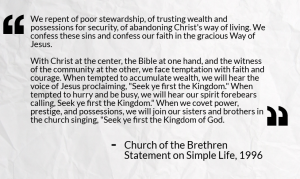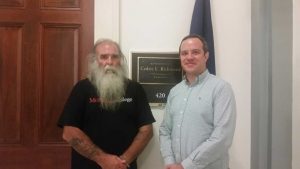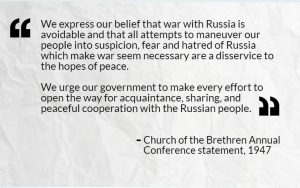By Nathan Hosler
Navajo activist Mark Charles’ lecture on “A Native Perspective on Columbus Day” is a valuable accompanying piece to this blog post. You can view it here.
“The arrival of Europeans was experienced by Native Americans as nothing less than an invasion. This invasion was not just of the land; it was an assault on the humanity of the native people and their holistic way of living. Europeans tended to regard anyone different from themselves as inferior subjects to be conquered and destroyed.”
-1994 Church of the Brethren Statement, “Community: A Tribe of Many Feathers”
Psalm 104
1 Bless the Lord, O my soul.
O Lord my God, you are very great.
You are clothed with honor and majesty,
2 wrapped in light as with a garment.
You stretch out the heavens like a tent,
3 you set the beams of your chambers on the waters,
you make the clouds your chariot,
you ride on the wings of the wind,
4 you make the winds your messengers,
fire and flame your ministers.
5 You set the earth on its foundations,
so that it shall never be shaken.
6 You cover it with the deep as with a garment;
the waters stood above the mountains.
7 At your rebuke they flee;
at the sound of your thunder they take to flight.
8 They rose up to the mountains, ran down to the valleys
to the place that you appointed for them.
9 You set a boundary that they may not pass,
so that they might not again cover the earth.
10 You make springs gush forth in the valleys;
they flow between the hills,
11 giving drink to every wild animal; the wild asses quench their thirst.
12 By the streams[e] the birds of the air have their habitation;
they sing among the branches.
13 From your lofty abode you water the mountains;
the earth is satisfied with the fruit of your work.
14 You cause the grass to grow for the cattle,
and plants for people to use,
to bring forth food from the earth,
15 and wine to gladden the human heart,
oil to make the face shine,
and bread to strengthen the human heart.
16 The trees of the Lord are watered abundantly,
the cedars of Lebanon that he planted.
17 In them the birds build their nests;
the stork has its home in the fir trees.
18 The high mountains are for the wild goats;
the rocks are a refuge for the coneys.
19 You have made the moon to mark the seasons;
the sun knows its time for setting.
The Doctrine of Discovery required that the land be empty of its indigenous inhabitants and made it morally good for Europeans to take and cultivate the land. By raising consciousness of how this continues to sustain and support the national myth and legal system, the church may repudiate its participation and propagation of this sin and seek ways to repent. Psalm 104 proclaims that the land is the Lord’s and that it is sustained and created through God. This psalm aligns more closely with Indigenous people’s understanding of the land as lived upon rather than owned by individuals. Chief Lawrence Hart (Southern Cheyenne) writes, “The earth is for the circle of people. And since the earth is for the whole, no one individual can own any part of it. The earth belongs to the Creator, and is gifted to peoples” (“The Earth is a Song Made Visible: A Cheyenne Christian Perspective,” Buffalo Shout, Salmon Cry, 155). By attending to both the Doctrine of Discovery and Psalm 104 we can recognize our rootedness in the land, as well as the fact that our understandings of ownership must be changed. Palestinian theologian Munther Isaac, in a biblical theology of land writes, “Human beings are only tenants in the land, and as such must share the blessings of the land with their neighbors….the land is something to share, not possess” (Munther Isaac, From Land to Lands, from Eden to the Renewed Earth, 370).
While geography encompasses all and should include all peoples as co-inhabitants, it has often been seen as a possession and its inhabitants as objects of conquest. The relationship to the land and its inhabitants is both affected by and has shaped understanding of race and ethnicity. Willie James Jennings in The Christian Imagination: Theology and Origins of Race writes, “The question of how one should imagine space is by far one of the most complex questions facing the world today. Space continues to be ever further enclosed inside the economic and political calculations of nation-states and corporations. Yet one imagines space as inseparably bound to how one imagines peoples and their places in the world. Although the history of Christians in the colonial West shows the difficulty of people imagining space and peoples together, Christianity itself offers hope of their joining…If space and race go together in the making of modern peoples, then what would be involved in the spatial and racial unmaking of modern peoples, that is, the remaking that should be the constitution of Christian people? This question poses a seeming impossibility, the transformation of social imaginations shaped in the fragmenting of place as private property and the slicing of human existence in racial vision” (Jennings, Christian Imagination, 250).
Getting wrong the relationship to land and other people is challenged first by Psalm 104 in recognition that the land is the Lords and in James 2:1-9. In the book of James unequal treatment is serious enough to call into question one’s connection to Jesus. We read,
My brothers and sisters, do you with your acts of favoritism really believe in our glorious Lord Jesus Christ ?2 For if a person with gold rings and in fine clothes comes into your assembly, and if a poor person in dirty clothes also comes in, 3 and if you take notice of the one wearing the fine clothes and say, “Have a seat here, please,” while to the one who is poor you say, “Stand there,” or, “Sit at my feet,” 4 have you not made distinctions among yourselves, and become judges with evil thoughts? 5 Listen, my beloved brothers and sisters. Has not God chosen the poor in the world to be rich in faith and to be heirs of the kingdom that he has promised to those who love him? 6 But you have dishonored the poor. Is it not the rich who oppress you? Is it not they who drag you into court? 7 Is it not they who blaspheme the excellent name that was invoked over you?
8 You do well if you really fulfill the royal law according to the scripture, “You shall love your neighbor as yourself.” 9 But if you show partiality, you commit sin and are convicted by the law as transgressors.”
James condemns favoritism. Simply seeking to give up favoritism still, however, allows us to retain for ourselves in the role of power. By imagining that it ours to welcome, we perpetuate the assumption of ownership and dominance. Of course, changing this does not mean that privilege simply disappears. While understanding power and privilege is critical to undoing oppression, theologically we are all in need of God’s grace, mercy, and justice. Jennings writes, “The colonialist moment helped solidify a form of Christian existence that read this text [Jesus healing the Canaanite woman] as though we were standing with Jesus looking down on the woman in her desperation, when in fact we, the Gentiles, are the woman…”(Jennings, 262).
Divisions within humanity (caused by the oppression of some over others) and between humanity and the land may be healed through the biblical understanding of shalom. Cherokee theologian, Randy Woodley, in Shalom and the Community of Creation: An Indigenous Vision though maintaining a strong critique more explicitly reflects on peacemaking through a comparative reading of the biblical idea of shalom and what he terms the Harmony Way. He writes, “In their nature as constructs, shalom and the Native American Harmony Way have much in common. Shalom, like Harmony Way, is made up of numerous notions and values, with the whole being greater than the sum of the parts. Both are meant to be a way of living life in concrete ways that include more than all the terms found within the construct” (Woodley, Shalom and the Community of Creation: An Indigenous Vision, x). This biblical vision of shalom, is acted out through a vocation of reconciliation (2 Corinthians 5:18, Romans 12-16-21, Matthew 5:9) which is defined by justice and seeking the well-being of all. (Mark Charles, a Navajo theologian and activist, uses the term conciliation rather than reconciliation since there was not a previous state of unity between European-American Christians and Native American communities. http://wirelesshogan.blogspot.com/2014/12/doctrine-of-discovery.html).
Along with the vocation of peacemaking the church is rooted in the land. Isaac writes, “A church in a particular land exists for the sake of that land and takes her mission agenda from it. The church, in other words, derives much of its purpose from its locale” (Isaac, From Land to Lands, 368). For Christians in the U.S. this rootedness and connection to the land requires a recognition of whose land this was and how it came to be possessed. The church’s misappropriation of biblical “Promised Land” imagery was wrongly used to claim theological warrant to clear the land of Indigenous inhabitants. By following Isaac’s urge to understand that land is now universal but still connected to geography we begin to understand the call of the church in a particular land, in this case a land that has been stolen from others. In this context the vocation of reconciliation requires repentance, concrete action, and relationships based on listening and mutuality.







